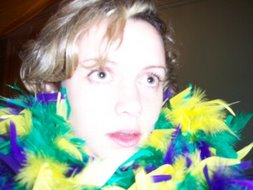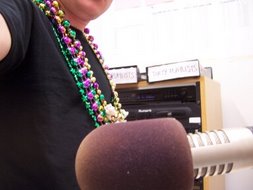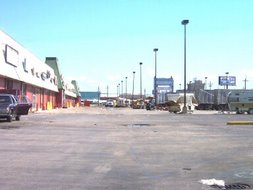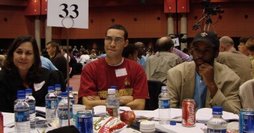
Where is Dr. Love?
I hurry past the French Market, scanning the crowd. Tourists drift by in healthy number, a good sign two weeks after Mardi Gras on a cool, overcast Sunday. Kim waits in the car outside Café Du Monde and when I reach her, she is still alone. Dr. Love is a no-show.
Which isn’t much of a surprise. The first time we told him of our plan, he protested the dangers involved.
“You know what an anaconda can do to you?”
Our second meeting took place Friday night, but Kim had to remind me on Saturday morning that we’d made a promise; I did remember Dr. Love and I talking in drunk-sincere tones. Now it’s Sunday, and Dr. Love hasn’t held up his end. Oh, well, he only had one club, anyway, and his fear of
snakes seemed quite real.
Our plan: play a few holes at the golf course in
City Park. We figured no one had swung a club there since the storm, so we’d likely be the first hackers to walk what now resembles the African Savannah. Dr. Love entered the picture when we met him at the Apple Barrel on Frenchman Street a few months ago and noticed him using two golf clubs as crutches. He was a slender black guy, looked to be around 65, and said he’d fought in Vietnam, the origin of his anaconda phobia. We were mostly interested in the clubs, though by Friday we’d already enlisted my friend, Tom, who had his own set, so now Dr. Love was the last member of our prospective foursome. But since he’d missed the meeting time, we continued on to Tom’s house in Lakeview.
(Click here for more photos)Lakeview, as its name suggests, abuts Lake Ponchatrain. One of the city’s most exclusive neighborhoods, it was also among the hardest hit by the storm. And though Lakeview’s relative affluence means it’s recovering faster than similarly devastated areas, it’s still a mess, with blocks of gutted homes, restored homes, and muddy front yards. A decorated Vietnam veteran himself, and a lifelong pal of my father, Tom suffered heavy losses from the storm, with ten feet of floodwater completely destroying the first floor of his home. After being rescued from the second floor and spending time in Pittsburgh and in a friend’s house on the Riverbend, he moved back into his place about a month ago.
When we arrived, the golf clubs rested on the front porch. The set of Ping Zings had sat in the floodwater for 2 weeks and the bag still had some mildew on it, the heads and shafts of the clubs muddy and slightly rusted. A couple dozen Titleist balls were still in the pocket where Tom had stashed them prior to the storm, the head covers still sheathed the woods, and the grips were surprisingly intact. For this return to City Park, these were just the clubs we needed.
Before we left, Tom walked us down the block to show us “Desolation Row,” as he called it. Several identical shotgun houses stood in a line along an overgrown alleyway, all gutted, or so it appeared. We walked into the third house. It wasn’t gutted; in fact, it was barely touched.
Two playpens sat in the front room, along with a couch and coffee table, everything covered in mud and mold. A collection of men’s shirts still hung in the closet in the bedroom, and the bed still had sheets on it. In the next room, a wall of shelves heaved with warped books and dusty CD cases. A stereo, a desk, a bed, more CD’s, a poster of Charlie Parker, a map of Spain---all untouched. The kitchen was full of stacked dishes and all the markings of a busy life. We guessed that a young couple with two children had lived there.
The things they left behind, particularly the volumes of history and selection of jazz recordings, especially chilled me. This looks like my shit, I thought. I have that book; I own that CD. Whoever they were, these people never came back to get a thing; everything was as it was left before the storm. I’ve walked through a lot of freaky shit in the last few months, but this house of petrified life felt particularly creepy, like a nightmare where you recognize things you’ve never seen before in real life.
We left and walked back to Tom’s, put the clubs in the trunk of the LTD, and followed Tom’s directions to
City Park.
The park’s driving range is open now, and when we pulled into the parking lot, we could see men hitting balls along the concrete porch. I took a towel from the car to wear under the bag strap to protect my sweater from the mildew, but soon found the strap’s velour more than clean enough.
As we walked to the first tee, Tom reminded me that this was the first hole I ever played in New Orleans, back in the late summer of 1995 when he and I and my father came out for nine. Now the tee markers were gone and the first fairway spread out before us in ruin. The grass looked burned, hay-colored with pockets of green
weeds and mud hills. The oaks on either side of the fairway stood leafless and weathered, almost frazzled.
Tom unsheathed his driver for the first time since the storm, I pulled out a dusty three iron, and we handed Kim a sand wedge, as it was the shortest club in the bag. I dropped three balls onto the wiry grass and proceeded to stretch out a little and take practice swings. A non-golfer, Kim struck the first ball of the afternoon, and won a bet with Tom that she’d make contact on her first try, though the ball traveled only a few yards.
As Tom stepped up to make his first swing, a National Guard
Humvee appeared at the end of the cart path. It proceeded slowly towards us, its tan body a perfect camouflage against the devastated landscape. Undeterred by the approaching patrol, Tom hit two balls in a row in the Humvee’s direction and we laughed about our “journalists” alibi. It was my turn and as I took a practice swing, the Humvee reached us.
“How y’all doing?” I called over my shoulder to the two soldiers. I heard no response and took my swing. The ball cut a bit to the right but the distance wasn’t bad at all. After watching the ball land, I turned to see the
Humvee continuing down the cart path and into the parking lot. I felt like a phantom, like the soldiers didn’t even see us out there, like we were just ghosts of golfers past. Kim whacked her ball a few more yards, I picked up the bag, and the three of us made our way down the fairway.
The first thing we noticed was that this hole had been mowed at least once since the storm. Neighboring holes appeared more unkempt, but the grass on No. 1 was relatively low, though pocked with anthills. Every few yards we came upon another anthill, and though they looked dormant, a whack with a 3 iron revealed each to be populated by a swarm of
fire ants. Those bastards are having a field day out at City Park and I was careful to avoid them for the rest of the afternoon.
Tire tracks ran down the middle of No. 1, though they appeared too narrow for a Humvee. Clusters of weeds and
musk thistle hugged the edges of the fairway and sprouted here and there in the middle. The swamp is coming back. The centuries-old trees looked ghoulish and untamed. All over the fairway, insidiously and aimless, the spiky dandelions and soft clovers will take back this entire course in another year or two. The dead grass felt spongy and sprayed up each time one of us took a swing. We knew where the green was supposed to be and marched steadily towards it, knocking our Titleists as we went.
I hadn’t golfed in probably 4 years, but when I was a teenager I played semi-regularly for a few summers, mostly with my father. The game always struck me as too frustrating to enjoy, though I liked walking the freshly combed fairways and the feeling of striking the ball with the sweet spot of my club. My swing is decent enough, and I have a fair understanding of iron play and the proper velocity for certain shots.
Today, of course, this was all fairly pointless, and I took few practice swings, instead walking up to the ball, lining myself up, and hacking away. On No. 1, this worked fine, because the dead grass propped the ball up a bit off the ground, in effect teeing it up for each shot. Tom reached the green first, and when the three of us made it there, I pulled out the putter. The green was just as rough as the fairway, but the originally finer grass there had matted in different fashion, making it bumpy but fast enough to putt on. Tom selected a cropping of weeds in the center of the green as the hole, and we knocked our balls towards it. On the first hole, I’m guessing we took a total of 30-40 shots between us, and lost maybe 3 balls out of bounds. There was no pin to replace, and we made our way over to the ninth tee.
The ninth appeared completely untouched since the storm. The tee was thick with weeds separated by dried mud. We gave Kim the 3-iron and I took the sand wedge, skying up my first shot. As we began to walk, it quickly became evident that No. 9 was a total ball trap. The dried grass was a few inches thick, and walking was akin to trudging through fresh snow.
In the first 40 yards, we lost countless balls, as the grass swallowed them up. Several times, one of us would barely hit the ball, sending it two or three yards, then spend another 2 minutes trying to dig the ball out of the grass, into which it had settled like an egg in a nest. Large clumps of hay came up each time I swung, and several times I banged my club on the ground in faux-golfer fury, cutting a swath in the earth. No greenskeeper was there to catch me.
“Hey,” Tom reminded me. “A bad day on the golf course is better than a good day at the office.” Throughout the afternoon we made comments like that, complaining of slick greens, absent rangers, and thick rough, and citing “winter rules” when we made friendly drops or dug balls out of the grass. We joked a lot during the “round.”
On a deserted stretch of a park that 18 months ago sat under a few feet of water, I felt at times like we were at the bottom of the ocean, or on the surface of
another planet. I’m almost certain that ours were the first clubs swung through that grass since the storm, and likely ours were the first feet to tread some stretches of that land. Yet our footsteps were light, we laughed at our location, the pace of play was dreamlike and unburdened by time or score.
The course may never come back, but we played on it this afternoon. To employ golf terms, we live in a city of hazards, of gaping wounds in the landscape and destruction that trivializes idyllic games and the idea of “par.” With so much of the city’s
space crumbled and disfigured, it’s very hard to tell what’s off limits or out of bounds. At City Park, I felt like a humble pilgrim, ambling through a routine ritual that bore no resemblance to my soiled surroundings.
This happens now and again in New Orleans these days, a sensation that you’re uncovering a secret that sits in public view, or that you’re sneaking around in someone else’s house. More and more people return, but still there are vast expanses like City Park where nothing’s happened, and no one is around. The great thing about the golf course is that it’s public—anyone can go there, it belongs to all of us, it isn’t dangerous or up for grabs. So to swing a golf club there felt comforting, or rather, it felt like we were comforting the course, forgotten by a public with too much to worry about right now. And in a city where the
rules are a source of
frustration these days, we reveled in the freedom to make up the rules as we went along, to make believe we were out for a quick round of 3.
Eventually we reached a stretch of fairway that was slightly mowed and finished out No. 9. We decided to walk back to the car, stopping at the ranger’s station to inspect the empty hut. There was no door and Kim went in and looked out at us through the dirty glass like she was working a summer job. Inside, we found everything gone save for a lone plaque dedicated to the winner of some tournament’s “Flight D.”
IDEA FOR A TOURNAMENT:
Nike or
Titleist or some company should sponsor an “Extreme Golf Challenge,” bringing Tiger Woods and
other golfers to play a few holes on the City Park course. The proceeds could go to restoring the park and the course and golf lessons for children. And I wonder how the pros would fare in conditions like this, which make Scotland look like a country club in Florida. Who wouldn’t pay to see that?
We drove to another section of the course, closer to the art museum, and teed off in front of a grove of immense oaks. As we set up for our second shots, a Siberian Husky or possibly a
Malamute came running onto the fairway. It circled Kim and me, then crossed the road that runs through the course, and disappeared into the wilds.
“Look out for that wolf!’ I yelled at Tom, who was searching in vain for his ball under a tree. A minute later, the dog’s owner appeared, smoking a cigar and wearing all black. We directed him up the road, and after awhile he sauntered back across, wolf in tow.
On the green, we made our final shots into a cluster of clover and shook hands. “Good game.” Later at lunch, we promised to play on the first Sunday of every month, and I’m pretty sure we’re going to stick to that. As I said, golf never was my game, but this afternoon was different, something between golf and hiking, trespassing and reclamation. And I’m sure we’ll play better next round, knowing the lay of the land and all. Like a lot of things lately, we’ll just have to bring a lot of balls.

























































